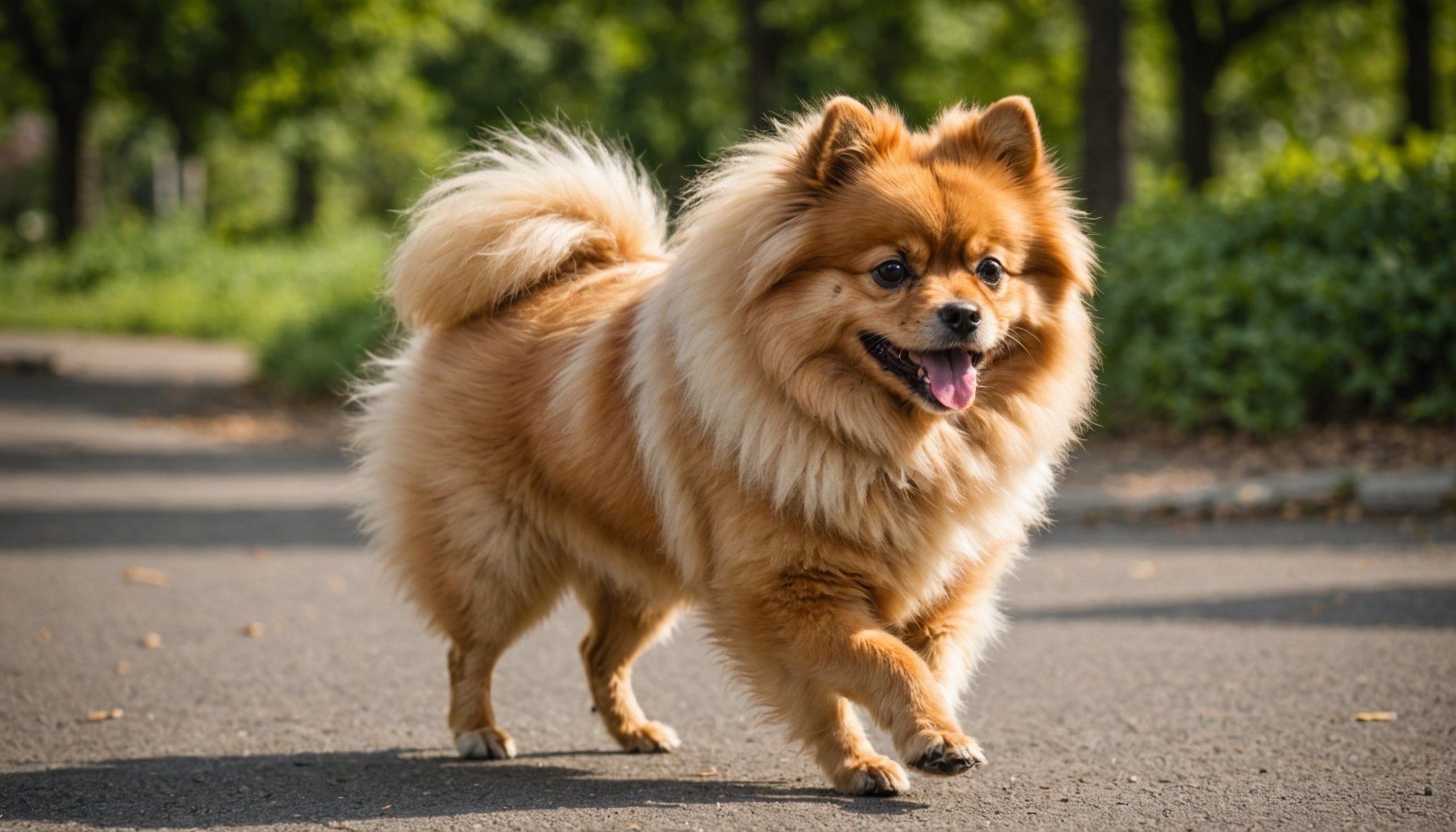Understanding Luxating Patella in Pomeranians
Luxating patella in Pomeranians is a common knee joint issue affecting their small and delicate frames. This condition occurs when the kneecap dislocates or moves out of its normal position, causing discomfort and potential mobility issues. It is often seen in toy breeds due to their bone structure. Causes include genetics, anatomic abnormalities, or trauma, making it crucial to be aware of this condition.
Identifying the common symptoms involves observing your Pomeranian’s behaviour. Limping, skipping steps, or an unwillingness to walk or run are indicative signs. Dogs may also extend their legs or stretch frequently to relieve discomfort. If left unaddressed, this can lead to significant pain and arthritic changes over time.
Also to read : Ultimate guide to preventing and managing fur matting in long-haired cats: tips and tricks for happy grooming
The importance of early diagnosis cannot be overstated. A veterinary consultation will provide a proper assessment and prevent further complications. Regular check-ups with a veterinarian will help monitor the condition and allow for a tailored management plan. Awareness and timely intervention are key to maintaining your pet’s quality of life and mobility. Early management, combined with appropriate therapeutic interventions, will ensure your Pomeranian enjoys its daily activities with minimal discomfort.
Benefits of Custom Fitness Regimens
A custom fitness regimen can significantly enhance a Pomeranian’s overall health, primarily by boosting muscle strength to support joint stability. This tailored approach not only stabilizes the fragile knee joint but also reinforces their small, delicate frames, keeping the risk of luxating patella at bay.
In parallel : The complete handbook for seamlessly integrating your rescue parrot with other birds
Fitness regimens work wonders for reducing pain and improving quality of life. By carefully strengthening the muscles around a Pomeranian’s joints, you can ease discomfort and promote smoother movement. This alleviation translates into enhanced mobility and more active playtimes.
The positive impact of a well-planned exercise plan extends beyond immediate physiological benefits. It can influence a Pomeranian’s overall health and longevity. Engaging in regular, structured activities improves cardiovascular health, controls weight, and strengthens bones—critical factors in maintaining a lively, happy pet.
- Enhancing muscle tone maintains knee joint stability.
- Providing relief from discomfort assists in more active lifestyles.
- Contributing to longer, healthier lives through routine activity.
Custom fitness routines not only address immediate health concerns but also pave the way for a fulfilling life. Implementing them should prioritize Pomeranian-specific needs, ensuring both effectiveness and safety.
Tailored Exercise Plans for Pomeranians
Designing exercise plans specifically for Pomeranians is crucial in addressing luxating patella and enhancing their overall fitness. Understanding their small, delicate structure helps in creating routines that ensure both health and safety.
Warm-up Exercises
Warm-ups play a vital role in preparing your Pomeranian for physical activity, reducing the risk of injury. Gentle stretching, such as extending the legs and mild range-of-motion exercises, is recommended. Aim for two to three minutes of controlled movements and repeat these warm-ups before every activity session.
Low-Impact Workouts
Incorporating low-impact workouts is beneficial for maintaining Pomeranian fitness without putting too much strain on the joints. Walking on soft surfaces, like grass or specialised dog-friendly tracks, provides a great alternative to hard pavements. Swimming, a joint-friendly activity, helps increase motion without stress on the knee joint. Regularity in these activities maximises their effectiveness, aiming for sessions of about 15-20 minutes, a few times weekly.
Strengthening Exercises
Specific strengthening techniques can significantly improve joint stability. Utilising resistance bands for controlled leg lifts or gentle squats can strengthen the leg muscles. It’s essential to observe your pet’s response, adjusting the intensity and ensuring exercises remain enjoyable and productive. Monitoring your Pomeranian’s comfort prevents overexertion and fosters a positive experience.
Tips from Veterinarians
Ensuring optimal health and mobility for your Pomeranian necessitates expert professional guidance and vigilant physical monitoring. Veterinarians stress the significance of customised regimens tailored for specific needs, emphasising structured exercise plans and pet health tips. Consulting a veterinarian provides insight into creating balanced routines that complement each pet’s particular condition, further enhancing their knee joint stability.
Veterinarian advice suggests regular monitoring for signs of discomfort or pain during activities. Detecting subtle cues early, such as limping or reduced activity levels, allows quick regimen adjustments, preventing exacerbation of the condition.
Routine health checks are indispensable in maintaining your pet’s well-being; they provide essential feedback on your Pomeranian’s progress and the effectiveness of implemented fitness strategies, ensuring consistent improvement.
Veterinarians highlight the importance of an integrated approach—combining exercises with proper nutrition and regular expertise reviews. This holistic strategy enables better management of luxating patella, optimising pomeranian health. Adhering to these professional guidelines makes it possible to mitigate complications, leading to a happier, healthier canine companion.
Success Stories
Remarkable success stories of Pomeranians overcoming luxating patella serve as powerful motivators for pet owners. By integrating tailored exercise and fitness regimens, numerous Pomeranian owners have witnessed significant improvements in their pets’ mobility and overall well-being.
One inspiring account involves Charlie, a spirited Pomeranian suffering from severe knee joint issues. Through a carefully devised plan, which combined low-impact workouts and targeted strengthening exercises, Charlie regained his zest for life. His owner reports noticeable enhancements in Charlie’s mobility and decreased pain, thanks to consistent adherence to the regimen and regular veterinarian advice.
Pet recovery stories resonate because they demonstrate the tangible, positive outcomes of dedicated care. Veterinarians often share anecdotes of Pomeranians making remarkable recoveries, which showcase not only the pets’ resilience but also the owner’s commitment to implementing effective solutions.
These motivational cases highlight the transformative effect of addressing specific health needs with literacy and patience. Owners like Sarah, who sought out pet health tips and community guidance, have restored their fur babies to enjoying active, happy lives, offering hope and encouragement to others navigating the same path.
Additional Resources and Support
Owning a Pomeranian with luxating patella can be challenging, and accessing the right resources is crucial. Support groups and online forums dedicated to pomeranian health provide invaluable platforms for sharing experiences, tips, and advice. Members offer insights into managing knee joint issues, fostering a supportive community for pet owners facing similar challenges. These forums serve as a comforting reminder that you’re not alone in navigating these health concerns.
For more detailed information, several websites and books focus on pet care resources. These materials often delve into specific areas, such as effective fitness regimens and tailored exercise plans that support joint stability. They offer expert advice on enhancing pom mobility through structured routines, providing practical solutions for improving quality of life.
Community engagement plays a pivotal role in pet care. Through shared experiences, owners gain confidence in implementing new strategies and adapting to their pet’s evolving needs. Informative links to scientific articles and educational videos further contribute to a comprehensive understanding of luxating patella management.
By leveraging these resources, pet owners can make informed decisions, benefiting not just their Pomeranians but also strengthening the bond through proactive and educated care strategies.











